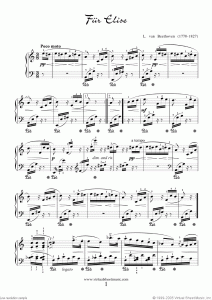[column width=”six” place=”first]httpv://www.youtube.com/watch?v=1mYfltBwrNY
[headline]Music Sheet[/headline]
[headline]Author[/headline]Ludwig van Beethoven was a German composer and pianist. Up till today, he still remains one of the most popular and influential composers of all time. Beethoven was born in Bonn, the capital of the Electorate of Cologne and part of the Holy Roman Empire. In his early 20s, he decided to move to Vienna to study with Joseph Haydn. That was also the time when his reputation as a pianist started to peak. Unfortunately, his hearing started to deteriorate when he was in his late twenties. Despite that, Beethoven continued to persevere and compose, conduct and even perform when he became completely deaf. Till today, he still remains as one of the most inspirational pianist of all time.
[headline]Interesting Fact[/headline]Fur Elise is known to be a bagatelle, which also means something of little or no value. However, this music piece is nothing like that! Although it’s only about 4 minutes, it is still one of Beethoven’s recognisable piece. Beethoven has a habit of only assigning opus numbers to his larger works, such as his symphonies. Unfortunately, this piano piece was never given an opus number. Hence, the WoO 59 came about, which is German for “werk ohne opuszahl”. This means “work without opus number” in English. It was assigned to the piece by Georg Kinsky in 1955.[/column]

